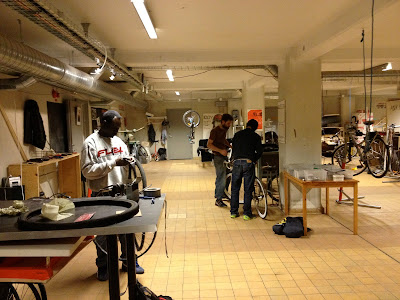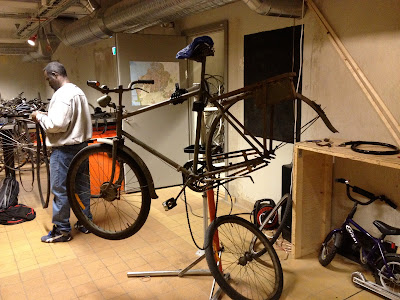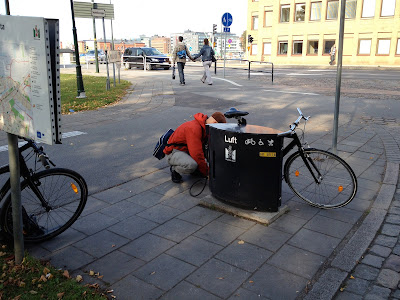so now that you have read my description of the
bike share system in Stockholm, it's time to talk about the pros, the cons, and the comparison between this system and others, most notably the two systems that I have seen and experienced,
Boston and
Copenhagen. what? you haven't read my previous post? shame on you! it's all about the Stockholm bike share system, City Bikes.
read it. you'll like it.
you may remember my not so glowing description of the
free bicycle share system in Copenhagen where you only need to slip a small coin (20 kroner or 2 Euro) into a slot to reserve a bike for as long as you want. at the time this system was launched (1990's), it was groundbreaking in many ways, especially for a well developed city and at such a large scale. my biggest complaint about that system is that because it is free, (some) people do not take responsibility for their actions and there is no accountability. I read articles about people putting the coin in the slot, riding the bike around, and literally throwing the bike(s) into the ocean and canals. vandalism of this nature is possible because there is no system to connect the person who "rents" the bike to the actual bike.
Stockholm took bike sharing to the next level by charging a fee to rent the bikes, by making a direct relationship between the bike and the renter, and by establishing some simple rules (including a slap on the wrist style punishment for violating the rules). so, how does the bike share in Stockholm compare to Copenhagen? well, for sure it is a step up in many ways, but it is not perfect either.
I made up a little chart to compare the three bike share programs using a 1-10 scale and assigning a score for each category with 9 as excellent and 1 as pretty bad. I compared the bike shares looking at these categories: number of stations, number of bikes per station, cost (guest), cost (season), bike quality, access (locations), access (availability of bikes), support, web/ app, ease of use of the system, and range/ time.
 |
| comparison chart of three bike shares: Boston, Stockholm, and Copenhagen |
let's start with
Copenhagen. the system is free (you put a 20 kroner coin in as a deposit but you get it back when you lock up the bike) which is amazing. but as I have said before, this leads to issues of vandalism and the feeling that there is no accountability because there is no way to track who is borrowing the bikes. an additional problem with this system is that people use their own locks on the bikes and basically treat them as personal bikes, riding them around and locking them up anywhere (often not at stations). almost every station I saw was without bikes and the few stations that had bikes often had problems (the bikes were stuck or locked with personal locks).
the other major problem with this system is that the stations are hard to find (they don't have a kiosk, signage, or any other way to recognize them). they basically look like regular bike racks. because there are so many bikes in Copenhagen, you might not even see the share rack buried under other bikes. in addition, people use the rack as a place to lock their personal bikes so the bike share rack might be completely full with non share bikes. the bike share in Copenhagen was innovative and impressive when it was started more than 15 years ago, but it has flaws that make it less successful than some of the newer systems, especially when directly compared categorically.
so let's look at
Stockholm's bike share, starting with the good aspects. Stockholm made some great improvements when compared to Copenhagen. they added inherent value to the system by making people pay to join. the amount per season is pretty reasonable, especially if you use the bikes a lot. they created many stations and spread them out well all over the city, which must have been a challenge because much of Stockholm central is a conglomeration of islands. the bikes are well distributed and there are almost always bikes at most stations and empty slots to return the bikes. the swipe NFC card seems to work well (although I had a problem once or twice and had to call the helpline) and the bike locking also seemed successful. the system is relatively easy to use. lastly, and most importantly (especially when compared to Boston), the allotment of time on the bike is long and the penalty for going over is minimal. you have three hours per trip and you get three strikes if you go over before they cut off your card (if you go for more than 5 hours they lock your card). three hours gives you quite a bit of time to travel around the city and even stop (not at a bike stand) if you are running errands. I would guess that these simple rules (along with a method to know who checked out the bike) keeps most people in line and keeps vandalism and other problems to a minimum.
the weaknesses in Stockholm are apparent once you've ridden a little bit. there are a bunch of bikes out there with problems (such as flat tires, broken lights, and wobbly wheels/ hubs). several of the bikes I picked up did not shift properly or the seats did not adjust and if there was another bike on the rack I would return the first one, which did present a problem once or twice. one time I rode home on a bike that had a really wobbly front wheel. I was going down a hill fearing a little for my life. another weakness of the Stockholm bike share is the 22.00 (10pm) curfew. I am not sure whether this is enforced, but it seems silly to limit the bikes to this arbitrary time. it's pitch black at 7pm now in October here, so why 10pm? and speaking of 10pm, why 6am for the start time? what if you need to be somewhere at 6am? and finally, the app to tell you where there are available spots to pick up a bike or lock your bike back to a stand costs $3. this should be free. you're already paying for a membership to use the bike.
so how does Boston compare? before we go too far here let me say that I have the least personal experience with this system because at home I ride my own bikes to work and around town. let's start with the good stuff. Boston's system is clearly the newest. the bikes are mostly in excellent shape. they shift properly, the lights work, etc. they are pretty well distributed throughout the central parts of the city and have expanded significantly in the second year of operation, which is hopefully a good sign of things to come. the app (run by an independent company called Spotcycle) is excellent and easy to use, as is the website. people that I have talked with who use the system say very positive things about getting around town on the bikes. the one time I called the helpline they were very supportive (although they could not fix the specific problem).
another excellent feature of the Hubway bike share is the range of options. you can sign up for one (24 hour) day for $5, a three day for $12, or a season membership. the one day pass is great if you know you are going to take two or more trips in and around the city (a subway/ metro pass costs about $2 per trip). the three day is great for a tourist or guest in the city. the system is versatile. one of the best parts about the Boston bike share system, especially when compared to Stockholm, is the overnight hours. you can use the bikes whenever you need (during the season) regardless of the time of day. this means the bikes are accessible to people outside of the 9-5 crowd such as dinner shift waiters, over night workers, and anyone who might need to be somewhere early (or late) in the day.
now to the "room for improvement". the thirty minute trip. I am not sure how Boston came up with 30 minutes (I have some guesses), but this does not give you much time to dilly dally. stations are close together and easily reachable within a couple of minutes, but what if you want to stop and smell the roses? or what if you want to roll somewhere quick to run an errand and then get back to drop the bike where you started? or what if you arrive to a station and the slots are full? now you have to book it to the next closest station. if you are cruising around town, it is annoying to have to always be on the lookout for a new station to swap bikes. the three hours of Stockholm might be too much, but 30 minutes seems too quick. how bout 45 minutes?
the other major problem is that the system has been seen by people as complicated. there are lots of instructions to read and understand and many people have complained that it is not crystal clear that you are automatically charged for more than a 30 minute trip. there are very heavy penalties for running over your time limit ($2 for the first 30 minutes over for a guest and up to $100 for 24 hours over). ouch. I understand the desire to keep the bikes circulating quickly and I am sure that there are specific reasons for heavy fees for overages and for the 30 minute trip, but (as someone who often pushes to the last possible minute) this seems pretty harsh. I'd love to see a less sharp fine, maybe some kind of warning, or even having 45 minutes instead of 30.
so who wins? well let's just say that when I ran the numbers, magically there was a tie between Boston and Stockholm. but, to satisfy those of you out there who need winners and losers, let me say two things. one, I think cities and bike culture are different across the world and needs vary depending on location, climate, culture, market demand, etc. what might work in Stockholm might not in Boston. for example, most people in Stockholm ride what people in Boston might call "crappy" bikes. they are not crappy, they are (often) old, beat up, and simple. this is acceptable because Swedish people have a stronger and older tradition of simple, functional bikes. so the bike share bikes are more aligned to that Swedish style than to Boston, which needs sharper looking and operating bikes to meet the market expectations. if the Boston fleet deteriorates to the level of Copenhagen, Boston people might simply stop riding the bikes. this may not be an issue in Stockholm or Copenhagen.
the second thing: any city that can successfully run a bike share system and support not polluting transportation options is a winner in my book. having the option of personalized transportation that puts air in your lungs, wind in your hair, and human powered wheels on the street is an excellent choice. thank you to all of the people who are making an effort to make bike travel, awareness, and sharing a successful strategy for transportation in Boston and in other places around the world. if you have never tried the bike share program in your city, check it out. you might be surprised about how easy it is and how it makes you feel.















































